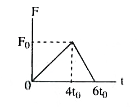A particle moves in XY plane under the influence of a force such that its linear momentum is ¯¯¯P=A[(coskt)ˆi+(sinkt)(−ˆj)] , where A and k are positive constants. Solution in Telugu
The magnitude of the force is Ak
The angle between force and momentum is π2
The angle between force and momentum is it π
The angle between acceleration and velocity vectors is always π/2
The correct Answer is:A, B, D
Step by step video, text & image solution for A particle moves in XY plane under the influence of a force such that its linear momentum is barP = A[(coskt)hati + (sin kt)(-hatj)] , where A and k are positive constants. by Physics experts to help you in doubts & scoring excellent marks in Class 11 exams.
Updated on:21/07/2023Topper's Solved these Questions
- NEWTONS LAWS OF MOTION BOOK - AAKASH SERIESCHAPTER - NEWTONS LAWS OF MOTION EXERCISE - LECTURE SHEET (EXERCISE - I) (Linked Comprehension Type Questions )
3 Videos
- NEWTONS LAWS OF MOTION BOOK - AAKASH SERIESCHAPTER - NEWTONS LAWS OF MOTION EXERCISE - LECTURE SHEET (EXERCISE - I) (Matrix Matching Type Questions )
1 Videos
- NEWTONS LAWS OF MOTION BOOK - AAKASH SERIESCHAPTER - NEWTONS LAWS OF MOTION EXERCISE - ADDITIONAL PRACTICE EXERCISE PRACTICE SHEET (ADVANECED) (Matrix Matching Type Questions)
1 Videos
- MOTION IN A STRAIGHT LINEBOOK - AAKASH SERIESCHAPTER - MOTION IN A STRAIGHT LINEEXERCISE - Questions for Descriptive Answers
7 Videos
- OSCILLATIONBOOK - AAKASH SERIESCHAPTER - OSCILLATIONEXERCISE - QUESTIONS FOR DESCRIPTIVE ANSWERS
12 Videos
Similar Questions
A ball of mass 'm' is thrown with a speed v0 towards a bat. It rebounds along the same speed 2v0 . The variation of interaction force between the bat and ball is shown

Maximum force exerted by the bat on the ball is
View SolutionBlock of mass 'm' is sliding up on the smooth incline plane, with some constant velocity. Now, on the block match the magnitude value of the forces on 'm' in the given directions take the components of all the forces in the given direction)

Column - IColumn -IIA) Net force component is horizontal direction P) zeroB) Net - force compnent in vertical directionQ) mgsinθcosθC) Net force component along the incline plane R)mgsinθD) Net force component perpendicular to the incline plane S) mg(1−cos2θ)
View SolutionThe system shown in the figure is given an acceleration 'a' towards left. Assume all contact surfaces to be smooth (m: mass of the sphere) The magnitude of the contact force between wedge and sphere between wedge and sphere at A is xmg√3 then 'x' is

View SolutionThree tortoises are located at the vertices of an equilateral triangle whose side equals a They all start moving simultaneously with velocity v constant in modulus with the first tortoise heading continually for the second , the second for the third and the third for the first . They will meet after time
View SolutionThe spring shown in figure is unstretched when a man starts pulling on the cord. The mass of the block is M. If the man exerts a constant force F, find the amplitude and the time period of the motion of the block.

View SolutionA particle moves in the X-Y plane under the influence of a force such that its linear momentum is oversetrarrp(t)=A[haticos(kt)-hatjsin(kt)] , where A and k are constants. The angle between the force and the momentum is
View SolutionA force F = -K(y hatI + x hatj) (where K is a posive constant ) acts on a particle moving in the xy plane . Starting form the original , the partical is taken along in the positive x axis to the point (x,0) and then partical to they axis the point (x,0) . The total work done by the force F on the particls is
View SolutionA particle moves in the xy plane under the influence of a force such that its linear momentum is →P(t)=A[ˆicos(kt)−ˆjsin(kt)], where A and k are constants. The angle between the force and momentum is
View SolutionA particle of mass m moves in xy plane such that its position vector, as a function of time, is given by vec(r) =b(kt-sinkt)hati+b(kt+cos kt) hatj . where b and k are positive constants. (a) Find the time t_0 in the interval o le t le (pi)/k when the resultant force acting on the particle has zero power. (b) Find the work done by the resultant force acting on the particle in the interval t_(o) le t le (pi)/4
View SolutionA particle moves in the XY-plane according to the law x=kt,y=kt(1−αt), where k and α are positive constants and t is time. The trajectory of the particle is
View SolutionA particle moves in the x-y plane under is influence of a force such that its linear momentum is →P(t)=A[ˆicos(kt)−ˆjsin(kt)], where A and k are constants Angle between the force and the momentum is:
View Solutionएक कण X-Y-तल में एक ऐसे बल के प्रभाव में चलता है कि कण का रेखीय संवेग →p(t)=A[ˆicos(kt)−ˆj(sinkt)] है, जहाँ A तथा k अचर है | बल तथा संवेग के बीच का कोण है :
View SolutionX-Y तल में एक बल के अन्तर्गत गतिशील एक कण का संवेग निम्न है p(t)=A(ˆicosbt−ˆjsinbt) जहाँ A और b स्थिरांक है। बल तथा संवेग के मध्य कोण है
View SolutionA particle moves in the X-Y plane under the influence of a force such that its linear momentum is vecp(t) = A[(wedge)icos (kt) -(wedge) sin (kt)] where A and k are constants. The angle between the force and the momentum is:
View SolutionA particle moves in the xy plane under the influence of a force such that its linear momentum is →P(t)=A[ˆicos(kt)−ˆjsin(kt)], where A and k are constants. The angle between the force and momentum is
View Solution
